Complete Guide to the Korean War Memorial in Washington DC. History, what to see and do, how to get to the park, and more.
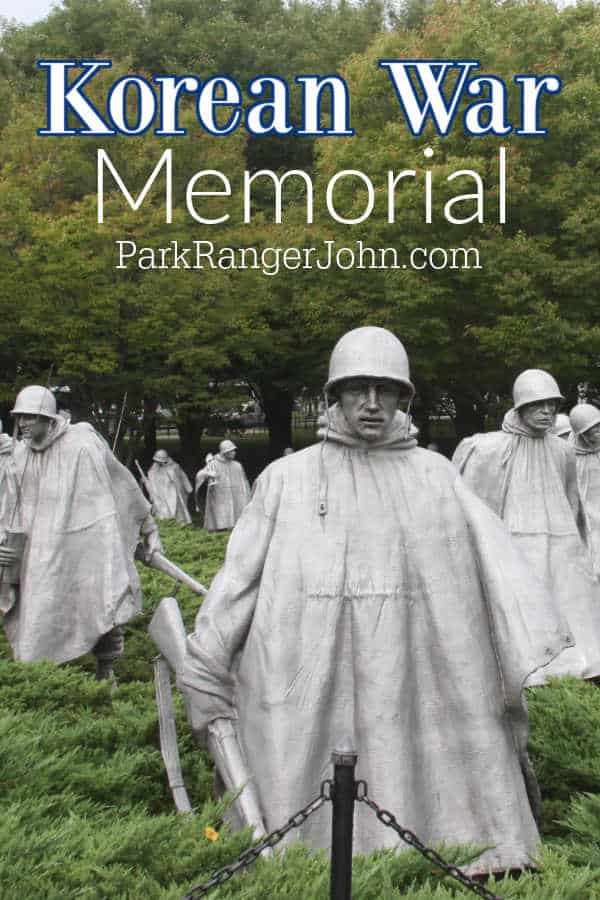
TL;DR Don’t have time to read the full article? Here are my top finds:
🏨Hotels and Vacation Rentals
📍Tours
🐻 Save time! Buy your National Park Pass before your trip
Korean War Veterans Memorial
The Korean War Memorial took my breath away when I first saw it. It feels like the soldiers are staring you in the eyes and following your movement.
I have heard that the memorial is absolutely amazing and scary at night. That the figures of the soldiers feel like they are moving when you see them.
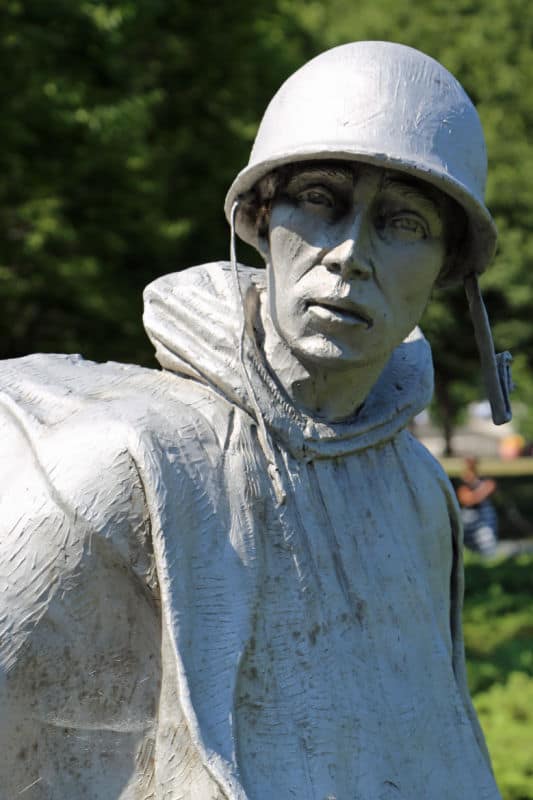
About Korean War Memorial
The Korean War Veterans Memorial was dedicated July 27, 1995, to commemorate the sacrifices of the millions of Americans and allied partners who fought during the Korean War.
From June 25, 1950, to July 27, 1953, 36,574 Americans died in hostile actions in the Korean War
The memorial is open 24 hours a day. Located near the Lincoln Memorial and Vietnam Veterans Memorial in Washington DC.
The Korean War Memorial includes 19 stainless steel statues that were sculpted by Frank Gaylord of Vermont. They were cast in New York before being brought to DC.
They stand approximately seven feet tall and represent an ethnic mix of America and the soldiers who fought in the Korean War.
The statues are in a juniper brush field and are separated by granite strips. They represent 14 Army, 3 Marine, 1 Navy, and 1 Air Force member.
The Juniper Brush field is to represent the rice paddies of Korea that troops would have encountered during the war.
The Korean War Veterans Memorial also features are Mural Wall designed by Louis Nelson from New York. This wall was created in Minnesota before being moved to DC.
The memorial wall has 41 panels that extend for 164 feet. The wall includes 2,400 photographs of the Korean War that was in the National Archives.
Make sure and look at the reflections in the Memorial Wall. You will see a total of 38 statues that symbolize the 38th parallel and the 38 months of the Korean War.
How many statues are at the Korean War Memorial?
There are 19 statues created by Vermont sculptor Frank Gaylord.
The statues include 14 soldiers, three Marines, one sailor, and one airman.
When was the Korean War Memorial Built?
The memorial was dedicated on July 27, 1995.
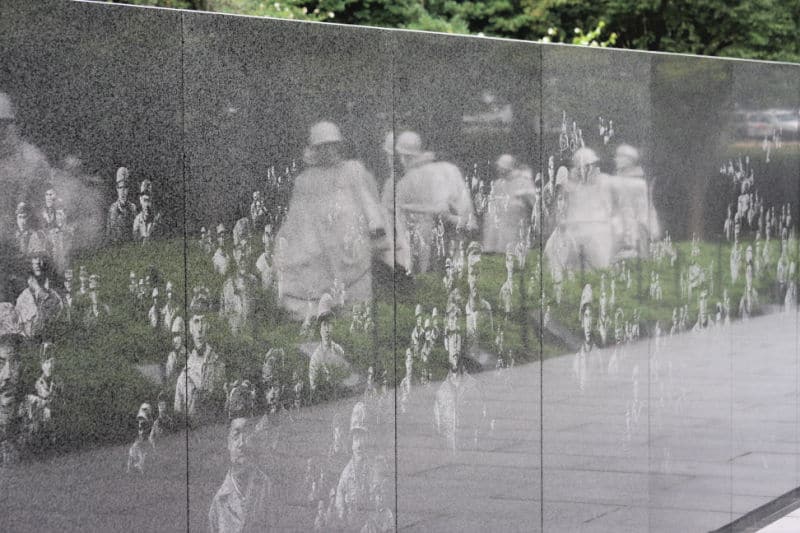
Is Korean War Memorial worth visiting?
Yes! This National Memorial offers visitors the chance to reflect on the Korean War and pay tribute to the service men and women who were lost during the war.
History of Korean War Memorial
The Korean War Veterans Memorial remembers and honors the American men and women who died or went missing in action during the Korean War. The memorial also remembers the men and women of the United Nations who fought alongside American and Korean forces.
The war is often referred to as the "forgotten war" despite it claiming over 40,00 American servicemen and women's lives. Beginning in 1950 and ending in 1953, the Korean War was the first proxy war of the Cold War. Formally a Japanese colony, it was left to the Soviet Union and the United States to decide what to do with Korea.
In 1945 Korea was split along the 38th parallel giving the Soviets control of the north and the US the south.
By 1950, each side was ruled by a dictatorship. North of the parallel was communist and anti-communists in the south. When the north invaded the south in June 1950, it sparked fears in Washington that the Communists were trying to take over not just Korea but the world.
The First Year
Tensions had been high between the two sides of the Korean peninsula since 1945, with over 10,000 soldiers having lost their lives in border skirmishes before the war broke out.
The Communist dictator of North Korea, Kim Il-Sung wanted to unify the peninsula and, with Soviet backing, invaded the south in June 1950.
Amidst fears that the Soviets were trying to take over the world, the U.S and UN decided that military intervention was needed. The Soviet-backed North Korean forces initially took the South Korean capital of Seoul. While the U.S and UN forces fought hard to make headway against the organized North Korean forces.
The U.S and South Korean forces made little progress against the well-equipped and organized North Korean army. North Korea tore through the south, committing heinous acts against civilians. By the end of August 1950, the U.S finally managed to slow the North Korean advance, including pushing them back at Pusan and retaking Seoul.
Allied Push Into North Korea
Initially, the UN and U.S wanted to push the Communists out of South Korea and back over the 38th parallel. This soon changed when the U.S forces, under the leadership of General MacArthur, landed in the North at Inch’on. Their intention became to liberate the North Koreans from their communist oppressors.
The landing at Inch’on was successful, and the U.S and South Korean forces managed to push the North Koreans back over the border. As the Allies made headway into the northern peninsula, the Chinese entered the conflict. Chairman Mao claimed that he felt the Chinese territory was under threat.
The Chinese forces entering the war escalated the conflict. The Chinese engaged with the US and South Korea at the Chosin Reservoir and managed to push the U.S back into South Korea.
The Chinese forces would attack the allies at night and cut off their supply lines. They would then attack and ambushed the retreating U.S forces. This tactic maximized their damage.
The Stalemate
American President Truman did not want to push the Chinese into a war for fear it would trigger a bigger world war. General MacArthur, however, disagreed with President Truman.
MacArthur thought that listening to Mao Zedong's threat of full-scale war with America was a sign of weakness and continued to push for war with China. Truman removed him as head of the U.S Forces.
President Truman, along with the United Nations, concluded that the best way to deescalate the situation in Korea would be to let go of the idea of reunification by force. Peace talks with North Korea and China stalled, and the war reached a stalemate.
The negotiations for peace did not stop the fighting. The negotiations merely changed how the U.S and UN fought. Rather than trying to claim more territory, they fought to hold onto those South Korean territories that they had.
The End of Negotiations
Peace negotiations continued for two years while the war continued and casualties on all sides mounted. The main reason the peace talks stalled was the issue of what to do with the prisoners of war.
China and North Korea believed the POWs should be repatriated by force while the U.S did not.
The North Koreans treated prisoners of war horribly, and it's feared that many prisoners were either executed or kept as slave laborers. In 1953, after two years of bloody conflict, the peace talks finally concluded. The negotiations ended with the North and South's continued separation at the 38th parallel. This division is still in effect today.
The Korean War had an exceptionally high civilian death toll, claiming the lives of over 2.5 million civilians. With an estimated 5 million total dead, 40,000 of which were U.S men and women who are remembered forever at the Korean Veterans War Memorial.
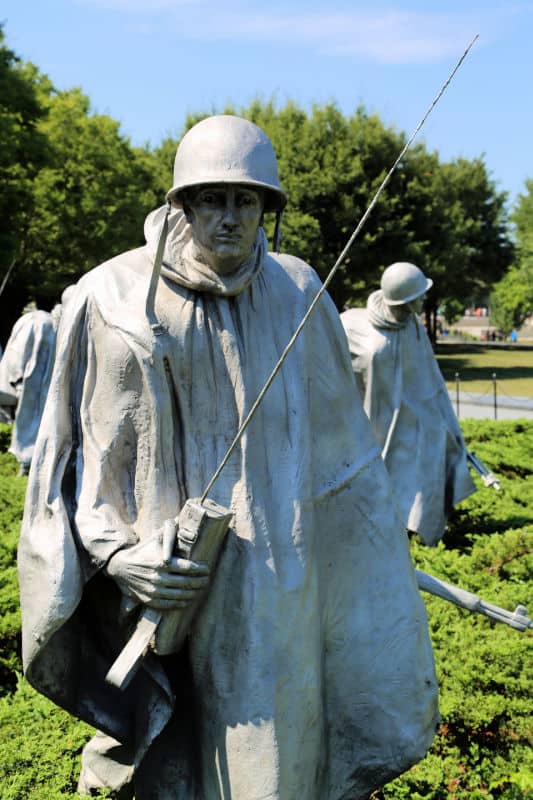
Things to know before your visit to Korean War Memorial
Entrance fee
$0.00 - There is no fee to visit the memorial
Learn more about National Park Passes for parks that have an entrance fee.
$80.00 - For the America the Beautiful/National Park Pass. The pass covers entrance fees to all US National Park Sites and over 2,000 Federal Recreation Fee Sites for an entire year and covers everyone in the car for per-vehicle sites and up to 4 adults for per-person sites.

Buy your pass at this link, and REI will donate 10% of pass proceeds to the National Forest Foundation, National Park Foundation, and the U.S. Endowment for Forestry & Communities.
National Park Free Entrance Days -Mark your calendars with the free entrance days the National Park Service offers for US citizens and residents.
Time Zone
EST - Eastern Standard Time
Pets
Leashed pets are allowed on the National Mall. They are not allowed in buildings, the National Sculpture Garden or in most memorials.
Cell Service
Cell Service should be great in Washington DC
Park Hours
The memorial is open 24 hours a day.
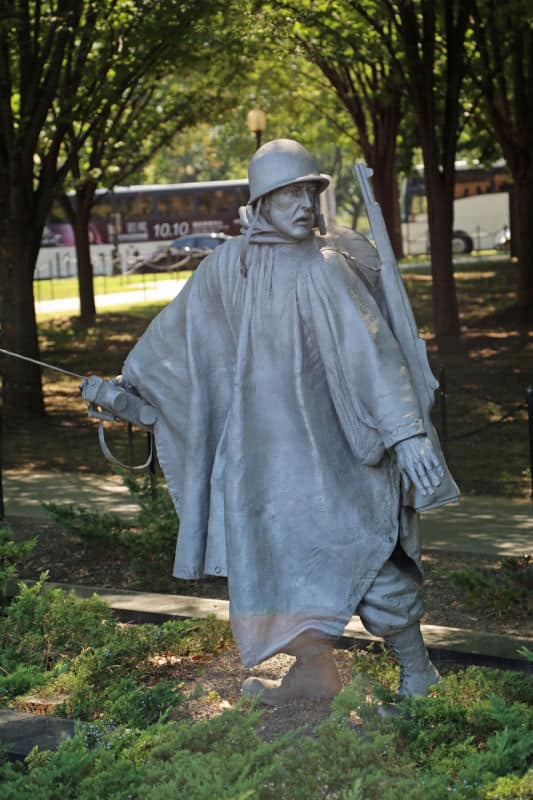
Wi-Fi
WiFi is not available in the park. It is available at nearby coffee shops and hotels.
Insect Repellent
Insect repellent is always a great idea when outdoors, especially if you are around any body of water.
We use Permethrin Spray on our clothes before our park trips.
Water Bottle
Make sure to bring your own water bottle and plenty of water with you. Plastic water bottles are not sold in the park.
Parking
Parking can be difficult to find. Parking is available along Ohio Drive, SW between the Lincoln and Thomas Jefferson Memorials.
There are 1,200 metered parking spaces through the National Mall area provided by the National Park Service.
These parking pay stations accept debit and credit cards. They do not accept cash or coins.
Payment can also be made via the Parkmobile app or website.
Metered parking can be found:
- Constitution Avenue NW between 15th Street NW and 23rd Street NW
- Parkway Drive SW
- Ohio Drive SW in West Potomac Park (between Independence Ave and Inlet Bridge)
- West Basin Drive SW (entire length, between Ohio Drive and Independence Avenue)
- Tidal Basin parking lot (paddle boats)
- Madison Drive NW
- Jefferson Drive SW
- Lots A, B, and C on Ohio Drive SW (East Potomac Park)
- Lot on Buckeye Drive (adjacent to tennis courts)
There are 300 free parking spaces at Hains Point within East Potomac Park.
Accessible parking spaces are available for vehicles displaying disability parking permits, placards, and vehicle tags. In the areas where a parking fee is being charged visitors will need to pay for the accessible parking spaces.
Motorcycles can park in lots A, B, C areas off of Ohio Drive.
Food/Restaurants
There are no restaurants within the park. There are tons of Washington DC Restaurants nearby.
Gas
There are no gas stations within the park.
Drones
Drones are not permitted within National Park Sites.
National Park Passport Stamps
National Park Passport stamps can be found in the visitor center.
Make sure to bring your National Park Passport Book with you or we like to pack these circle stickers so we don't have to bring our entire book with us.
The Korean War Veterans Memorial is part of the 1997 Passport Stamp Set.
Electric Vehicle Charging
There are 500 public EV Charging Stations in Washington DC (Level 2 and Level 3)
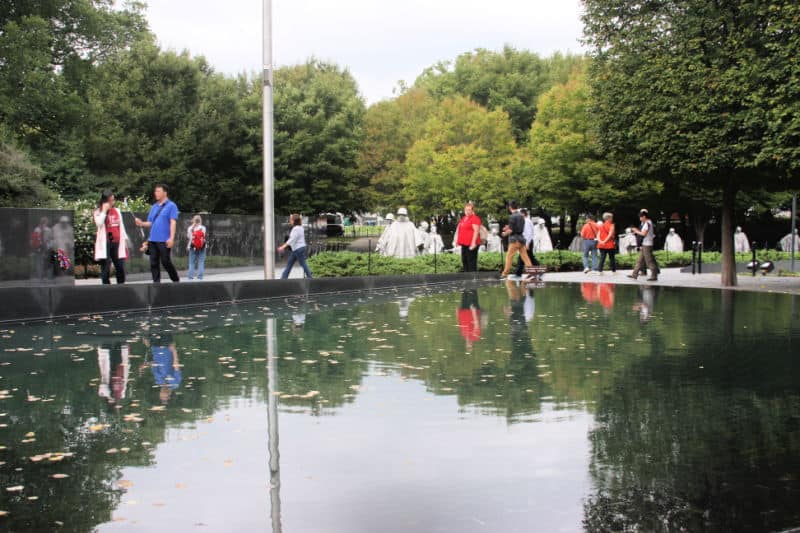
Details about Korean War Memorial
Size - 1.56 acres
The Korean War Veterans Memorial is one of the smallest National Parks by Size.
Date Established
July 27, 1995 - The site was dedicated on the 42nd anniversary of the armistice that ended the Korean War.
National Park Address
10 Daniel French Drive SW
Washington, DC 20002
Korean War Memorial Map

There are great walking maps for Washington DC that offers information on a street and site by site basis.
We have used these popout maps before. They are small and easy to carry with you.
There is also a National Geographic Destination City Map available on Amazon.
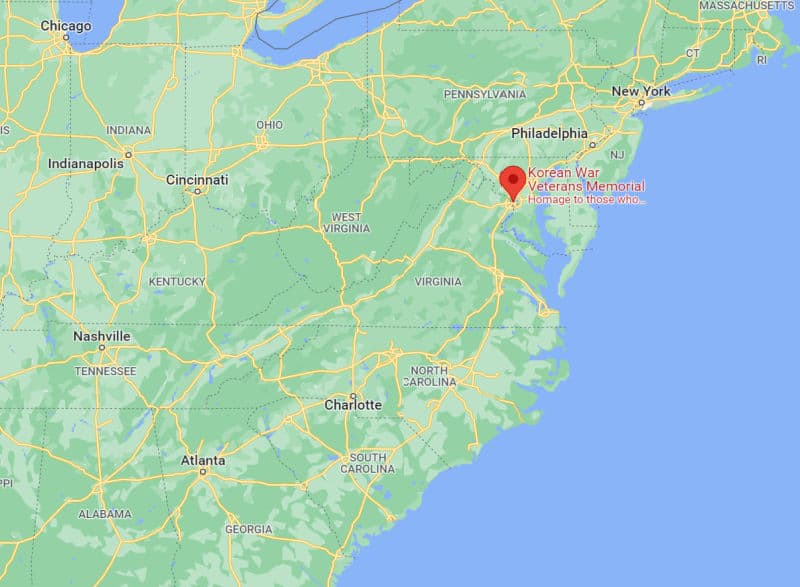
Where is Korean War Memorial?
The Korean War Veterans Memorial is located on the National Mall in Washington DC near the Lincoln Memorial.
Estimated distance from major cities nearby
Baltimore, MD - 41 miles
Philadelphia, PA - 142 miles
Norfolk, VA - 199 miles
Virginia Beach, VA - 206 miles
Pittsburgh, PA - 245 miles
Newark, NJ - 220 miles
Jersey City, NJ - 226 miles
New York, NY - 229 miles
Estimated Distance from nearby National Park
Shenandoah National Park - 69 miles
New River Gorge National Park - 293 miles
Mammoth Cave National Park - 674 miles
Congaree National Park - 481 miles
Acadia National Park - 710 miles
Cuyahoga Valley National Park - 349 miles
Indiana Dunes National Park - 656 miles
Where is the National Park Visitor Center?
Rangers are on duty to answer questions from 9:30 am to 10:00 pm daily. They provide interpretive programs throughout the day and upon request.
The only day Park Rangers are not present is on Christmas.
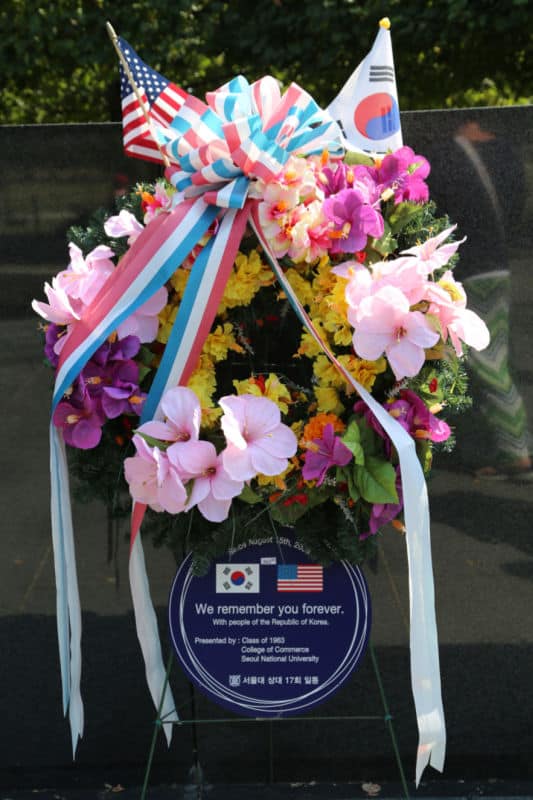
Getting to Korean War Memorial
Closest Airports
Ronald Reagan Washington National Airport
Washington Dulles International Airport
International Airports
Baltimore Washington International Thurgood Marshall Airport
Driving Directions
From the South - Interstate 395 provides access to the National Mall and Memorial Parks.
From the North - Interstate 495, New York Avenue, Rock Creek, and the Potomac Parkway, George Washington Memorial Parkway, and the Cabin John Parkway provide access.
From the West - Interstate 66, US Route 50, and US Route 29 provide access.
From the East - US Route 50, 1, and 4 provide access.
Public Transportation
Public Transportation is a great way to visit the parks. There are multiple options including the DC Subway System (Metro), or the DC Circulator Bus.
The closest Metro stops are Foggy Bottom or Federal Triangle on the Orange, Blue, and Silver lines.
On Off Bus Tour
One of our favorite ways to explore Washington DC is on an On Off Bus Tour.
This is the perfect way to let someone else do the driving. Plus, you can sit on the top deck and get epic pictures while riding around the city.
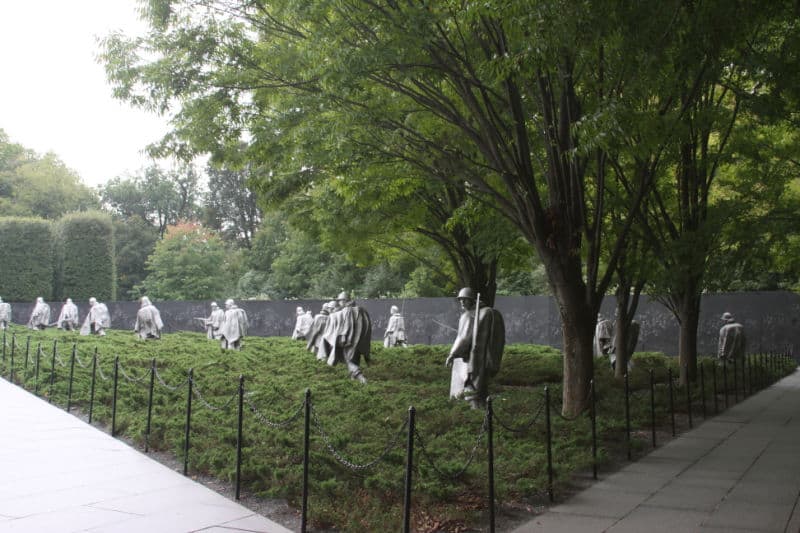
Best time to visit Korean War Memorial
The best time to visit Washington DC is June and then Mid August to early October. The weather should be nice without being crazy muggy or hot.
Weather and Seasons
Summers are warm and muggy in Washington DC while winters are super cold and snowy.
The hottest weather is from May 30 to September 16th when the average daily temperature is above 79 degrees.
The coldest weather is from December 1st to March 4th with an average temperature below 52 degrees.
The coldest month is January. May gets the most rain with an average of 3.5 inches.
February gets the most snow with an average of 5.4 inches.
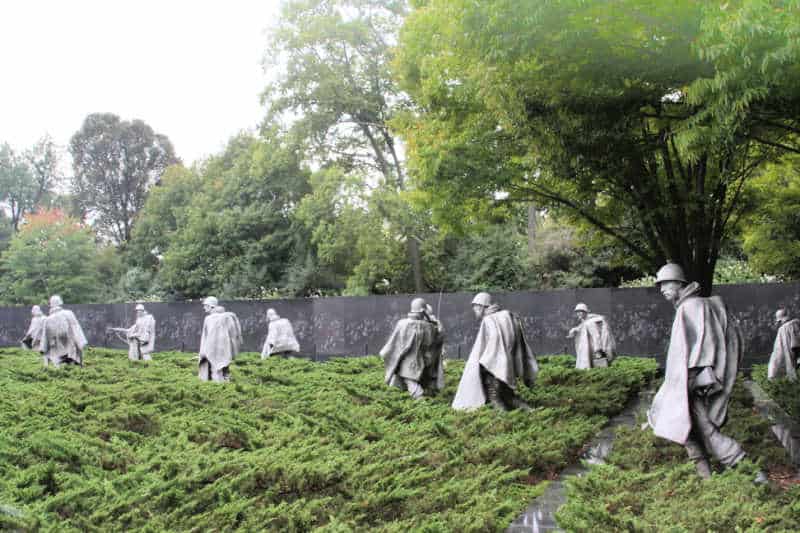
Best Things to do in Korean War Memorial
The Korean War Veterans Memorial includes the stainless steel figures in a triangle shape, the reflection wall with images of uniformed servicemen to represent all who served, and the reflecting pool with benches around it.
Statues
There are 19 stainless steel statues of soldiers within a triangle. The statues were sculpted by Frank Gaylord from Vermont.
The statues are approximately 7 feet tall and represent multiple ethnicities. They include 14 Army, 3 Marine, 1 Navy, and 1 Air Force service member.
The statues are positioned in juniper bushes and separated by polished granite strips. The statues are dressed in ponchos that cover their weapons and equipment with the ponchos looking like they are blowing in the cold winds of Korea.
Statue 1 - Army Lead Scout
Statue 2 - Army Scout
Statue 3 - Army Squad Leader
Statue 4 - Army BAR Man
Statue 5 - Army BAR Assistant
Statue 6 - Army Rifleman
Statue 7 - Army Group Leader
Statue 8 - Army Radio Operator
Statue 9 - Army Medic
Statue 10 - Army Forward Observer
Statue 11 - Air Force Air Ground Controller
Statue 12 - Marine Corps Assistant Gunner
Statue 13 - Marine Corps Gunner
Statue 14 - Navy Corpsman
Statue 15 - Marine Corps Rifleman
Statue 16 - Army Rifleman
Statue 17 - Army Rifleman
Statue 18 - Army Assistant Group Leader
Statue 19 - Army Rifleman
Mural Wall
The Mural Wall was designed by Louis Nelson of New York, NY, and fabricated by Cold Spring Granite Company, Cold Spring, MN.
The mural wall has 41 panels extending 164 feet. The mural wall depicts Army, Navy, Marine Corps, Air Force, and Coast Guard personnel and their equipment that supported foot soldiers.
The reflection on the black granite creates 38 statues which is symbolic of the 38th parallel and the 38 months that the Korean War lasted.
From a distance it also appears to show the mountain ranges of Korea. The panels are organized by US Army, US Air Force, and US Navy.
Pool of Remembrance
The pool of remembrance is approximately 128 feet in diameter. The triangle that surrounds the statues reaches into the pool.
There are 28 Linden Trees that surround the pool. Located under the trees there are seven benches so visitors can sit and reflect.
The wall that extends into the pool includes the words - Freedom is not Free.
Honor Roll
There is a kiosk at the west entrance of the memorial that contains the Korean War Honor Roll.
This computer has the names of all military personnel who lost their lives during the Korean War. It includes the persons name, service, rank, service number, date of birth, hometown or country of entry, cause of death, date of death, and if available their awards and photo.
United Nations Wall
22 nations participated in the Korean War. Their names are listed in alphabetical order on the curb running along the northern side of the statues.
The nations listed include: Australia, Belgium, Canada, Colombia, Denmark, Ethiopia, France, Greece, India, Italy, Luxembourg, Netherlands, New Zealand, Norway, Philippines, Republic of Korea, South Africa, Sweden, Thailand, Turkey, United Kingdom, and the United States of America.
Dedication Stone
The dedication stone is located at the point of the triangle leading to the American Flag. It reads:
Our nation honors her sons and daughters
who answered the call to defend a country
they never knew and a people they never met
The Wall of Remembrance
July 27, 2022 there will be an additional Wall of Remembrance unveiled at the Korean War Veterans Memorial.
The Remembrance Wall will include the names of approximately 36,000 Americans who died supporting the Korean War and more than 7,100 Korean Augmentation to the United States Army (KATUSA) who died while helping the Army.
The names will be organized by rank and branch of service.
United States Army - 29, 857
United States Marine Corp - 4,522
United States Navy - 668
United States Air Force - 1,587
Construction of the wall began in March 2021. The Remembrance Wall will encircle the Pool of Remembrance.
During the rehabilitation of the Korean War Veterans Memorial the Korean War Veterans Memorial Foundation is also repairing the pavement, refinishing the stainless steel statues, replacing the Linden Trees around the Pool of Remembrance, replacing the Juniper Trees in the Field of Service, and updating lighting with high-efficiency LED Lamps.
Junior Ranger Program
The National Mall and Memorial Parks are all part of the same Junior Ranger program.
Guided Tours
A great way to visit the Memorial and other park sites is on a guided tour.
This is the perfect way to learn more about the sites without having to worry about driving and parking in town.
Washington DC Full Day Tour - This tour visits the White House, Capitol Building, Thomas Jefferson Memorial and includes a scenic river cruise.
Washington DC Segway Tour - This tour through Washington DC visits more than 25 historic buildings, monuments, and memorials.
6 hour sightseeing tour - This 6 hour tour includes a boat cruise on the Potamic River during the summer.
Brunch or Dinner Cruise - Enjoy the ultimate views of Washington DC on a custom designs boat. Savor a delicious plated brunch with mimosas or a gourmet 3-course dinner served at your private table, then relax to the curated background music.
There are a ton of tours available in Washington DC! From food tours to ghost tours you can find an amazing tour to enhance your visit.
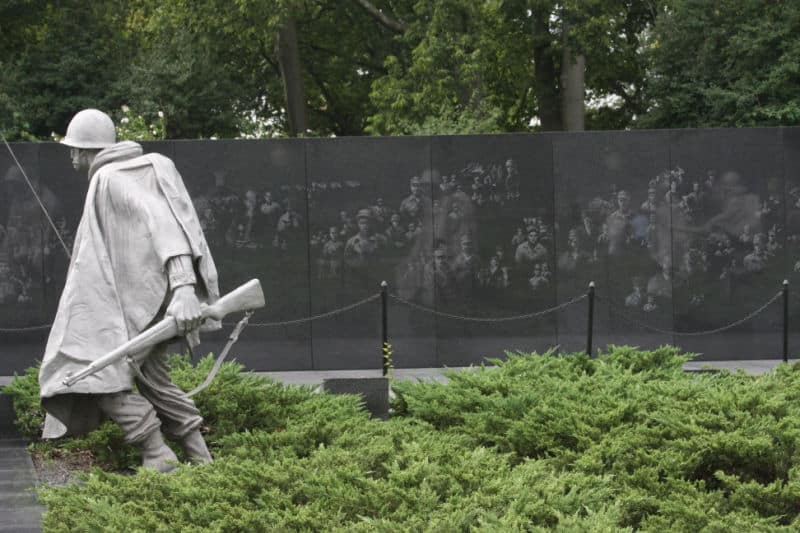
How to beat the crowds in Korean War Memorial?
The best way to beat the crowds is to arrive early in the morning and later in the evening.
Where to stay when visiting Korean War Memorial
There are no National Park Lodges in Washington DC.
Lodging near the Lincoln Memorial includes:
Fairmont Washington, D.C - This aparthotel features an indoor pool, a restaurant, and a health club. Other amenities include a bar/lounge, a sauna, and WiFi in public areas. Each apartment offers WiFi, an iPod dock, and an LCD TV with cable channels. Added amenities include 24-hour room service, wired Internet, and premium bedding.
Hilton Washington DC Capitol Hill - 4-star hotel near National Mall. Hilton Washington DC Capitol Hill is located close to Union Station Shopping Center and United States Capitol, and provides dry cleaning/laundry services, a bar, and a gym. Stay connected with free in-room Wi-Fi, and guests can find other amenities such as a conference center and a restaurant.
Riggs Washington DC - 5-star luxury hotel. Close to Walter E. Washington Convention Center and National Museum of African American History and Culture, Riggs Washington DC provides a terrace, a garden, and dry cleaning/laundry services. The onsite American cuisine brasserie, Cafe Riggs, features brunch and light fare. Stay connected with free in-room Wi-Fi, and guests can find other amenities such as a bar and a 24-hour health club.
Courtyard by Marriott Washington, DC - Located in Washington (Foggy Bottom), Courtyard by Marriott Washington, DC/Foggy Bottom is within a 15-minute walk of George Washington University and Vietnam Veterans Memorial. This hotel is 0.6 mi (1 km) from White House and 0.7 mi (1.1 km) from Lincoln Memorial.
Holiday Inn Washington-Central/White House - Close to Walter E. Washington Convention Center and George Washington University, Holiday Inn Washington-Central/White House, an IHG Hotel provides shopping on site, an arcade/game room, and dry cleaning/laundry services. Be sure to enjoy a meal at Johnny Rockets Restaurant, the onsite restaurant. In addition to a bar and a gym, guests can connect to free in-room Wi-Fi.
Click on the map below to see current rates for vacation rentals and hotels in Washington DC and surrounding area.
Camping
There are no National Park Campgrounds near the memorial.
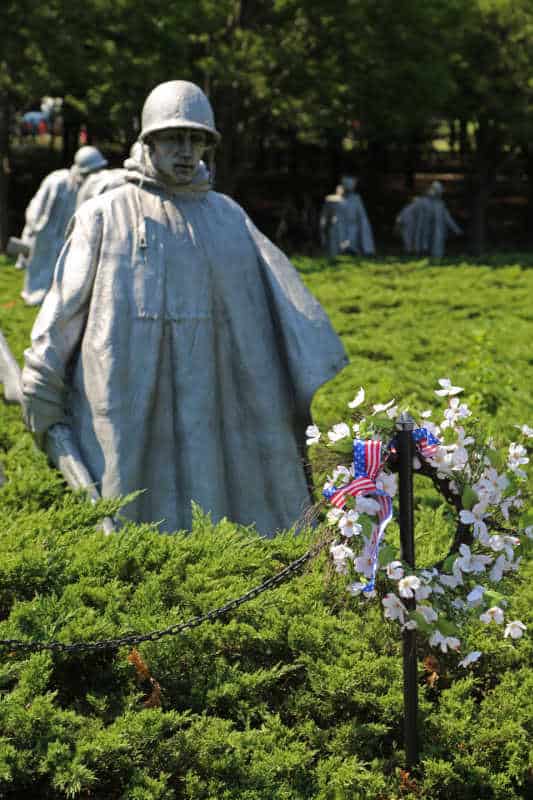
Additional Resources
On Desperate Ground: The Epic Story of Chosin Reservoir--the Greatest Battle of the Korean War
The Coldest Winter: America and the Korean War
The Korean War: A History (Modern Library Chronicles)
Secret Washington DC: A Guide to the Weird, Wonderful, and Obscure
Parks Near Korean War Memorial
Martin Luther King Jr. Memorial
Franklin Delano Roosevelt Memorial
Washington Monument
Check out all of the National Parks in Washington DC
Check out all of the National Parks in Virginia along with National Parks in Kentucky, National Parks in Maryland, National Parks in North Carolina, Tennessee National Parks, and West Virginia National Parks
Check out all of the US National Memorials
Make sure to check out all of the great things to do with kids in Washington DC
Make sure to follow Park Ranger John on Facebook, Instagram, Pinterest, and TikTok


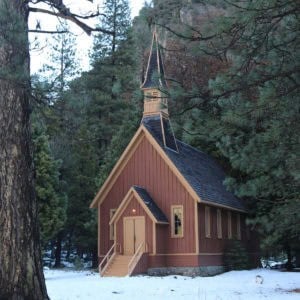
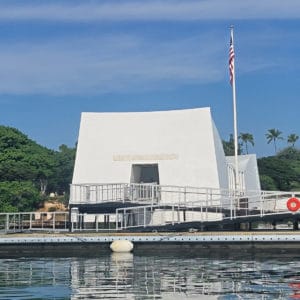
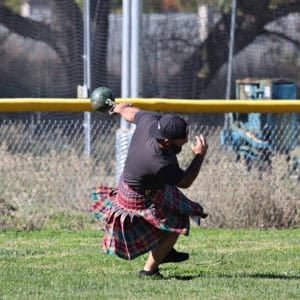
Leave a Reply